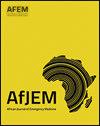Critical care transfers of ventilator-dependent patients from operating theatres to Critical Care Units in a South African Metropole
IF 1.2
4区 医学
Q3 EMERGENCY MEDICINE
引用次数: 0
Abstract
Background
Ventilated patients in the operating theatre who need transfer to other facilities, can contribute to delays and inefficencies in surgical and theatre resources. In 2018, an interhospital retrieval service was established to provide transfers between state hospitals in the Cape Town Metropole exclusively for intubated, post-operative patients. This study aims to describe the utilisation of the retrieval system and gain insights into retrieval patterns.
Methods
This retrospective observational study analysed all post-operative patients using the retrieval system between state hospitals in the Cape Town Metropole from July 2018 – December 2021, as recorded in an existing SPRINTT-OR registry.
Results
A total of 291 patients were included. Most patients retrieved were male (n = 186, 63.9 %), with a mean age of 34.95 (S ± 13.59). The median time interval from request to ambulance arrival was 61 min. Most patients (n = 184, 63.2 %) were transferred from a single Large Metro District Hospital (LMDH). Trauma surgery was the most common diagnostic category (n = 123, 42.3 %), followed by infective causes (n = 79, 27.1 %) and Obstetrics & Gynaecology (n = 52, 17.9 %).
Conclusion
This study provides insight into the retrieval needs of ventilated, post-operative patients across different healthcare facilities in an African metropolitan area who are transferred with a dedicated, specialised transfer service. It describes the system's use and provides insight into patient demographics, diagnoses, and transfer timing, as well as the role of Emergency Medical Services (EMS) in optimising the functioning of a healthcare system.
南非大都市呼吸机依赖患者从手术室到重症监护病房的重症监护转移
背景手术室内需要通风的患者需要转移到其他设施,可能会导致手术和手术室资源的延误和效率低下。2018年,建立了一项医院间检索服务,专门为开普敦大都会的公立医院之间的插管术后患者提供转诊服务。本研究旨在描述检索系统的使用,并深入了解检索模式。方法本回顾性观察性研究分析了2018年7月至2021年12月在开普敦大都会州立医院使用检索系统的所有术后患者,这些患者记录在现有的sprint - or登记处。结果共纳入291例患者。大多数患者为男性(n = 186, 63.9%),平均年龄34.95 (S±13.59)岁。从请求到救护车到达的中位时间间隔为61分钟。大多数患者(n = 184, 63.2%)来自单一的大型都会区医院(LMDH)。创伤外科是最常见的诊断类别(n = 123, 42.3%),其次是感染原因(n = 79, 27.1%)和妇产科(n = 52, 17.9%)。结论:本研究提供了对非洲大都市地区不同医疗机构的通气术后患者的检索需求的见解,这些患者通过专门的专业转移服务转移。它描述了系统的使用,并提供了对患者人口统计,诊断和转移时间的见解,以及紧急医疗服务(EMS)在优化医疗保健系统功能中的作用。
本文章由计算机程序翻译,如有差异,请以英文原文为准。
求助全文
约1分钟内获得全文
求助全文
来源期刊

African Journal of Emergency Medicine
EMERGENCY MEDICINE-
CiteScore
2.40
自引率
7.70%
发文量
78
审稿时长
85 days
 求助内容:
求助内容: 应助结果提醒方式:
应助结果提醒方式:


